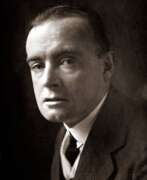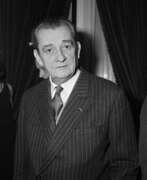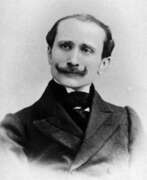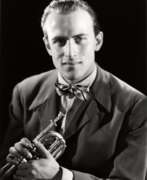Playwrights 20th century


Jean Maurice Eugène Clément Cocteau was a French poet, playwright, novelist, designer, filmmaker, visual artist and critic. He was one of the foremost creatives of the surrealist, avant-garde, and Dadaist movements; and one of the most influential figures in early 20th-century art as a whole. The National Observer suggested that, “of the artistic generation whose daring gave birth to Twentieth Century Art, Cocteau came closest to being a Renaissance man.”


Noël Peirce Coward was an English playwright, composer, director, actor, and singer, known for his wit, flamboyance, and what Time magazine called «a sense of personal style, a combination of cheek and chic, pose and poise».


Arthur Fauser was a German painter, graphic artist and playwright.
Arthur Fauser learned to draw virtually on his own, fulfilling graphic commissions. In 1934 he took part in anti-fascist organizations, was a soldier during World War II, and afterwards returned to art.
Since 1946, he has written radio plays and plays. Fauser also worked with black-and-white and color woodcuts and lithographs, depicting still lifes and landscapes. Later, along with watercolor and oil painting, etching became his favorite medium.
He was the father of the writer Jörg Fauser (1944-1987).


Hippolyte Jean Giraudoux was a French novelist, essayist, diplomat and playwright. He is considered among the most important French dramatists of the period between World War I and World War II. His work is noted for its stylistic elegance and poetic fantasy. Giraudoux's dominant theme is the relationship between man and woman—or in some cases, between man and some unattainable ideal.


Harry Sinclair Lewis was an American author, playwright and journalist, the first U.S. winner of the Nobel Prize in Literature (1930).
Lewis graduated from Yale University and soon wrote his first book, an adventure novel for young people, which was published in 1912 under the pseudonym Tom Graham. Other novels followed, but it was the publication of Main Street: The Story of Carol Kennicott in 1920 that made Lewis famous. This novel immediately became an international sensation and sold a large number of copies.
The 1920s were extraordinarily successful for Lewis. He wrote "Erowsmith" (1925), "Mantrap" (1926), "Elmer Gantry" (1927), "The Man Who Knew Coolidge" (1928) and "Dodsworth" (1929). Hollywood also made five movies based on his works during this decade. Lewis was awarded the Pulitzer Prize for the movie Erowsmith, but he declined the award, objecting to the judging criteria. Lewis also worked in various positions in the publishing industry, including editor and manuscript reader, and published his stories in magazines.
In 1930, Sinclair Lewis became the first American to win the Nobel Prize in Literature; he wrote eleven more novels afterward.


Pierre Mac Orlan, real name Pierre Dumarchey, is a French writer, poet, screenwriter, playwright, artist and journalist.
Pierre Dumarchey spent his youth leading a bohemian lifestyle, but by the age of 20 he had already published several collections of short stories with his own illustrations. He socialized with many contemporary writers and artists, played the accordion, and many of his songs were quite popular in cabarets. In World War
I in 1916, Pierre Dumarchey was wounded, after which he worked as a war correspondent. In the late 1920s, he became an influential critic of film and photography. And later became a famous writer under the pseudonym Pierre Mac-Orlan. Based on his most famous novel Quai des Brumes ("Port of Shadows"), French director Marcel Carné made a movie of the same name in 1938.
In addition to his numerous novels, Mac-Orlan published under various pseudonyms in erotic magazines. Pierre Mac-Orlan was a very prolific writer: in 1969-1971, a collection of his works in 24 volumes was published, which, however, did not include his many erotic works.


Jovan Mihailović is a Serbian and American musician, artist and writer.
Jovan Mihailović was born and raised in Belgrade, the capital of Serbia, where he and his family survived the Nazi occupation and the transition to communism. From a young age, he demonstrated artistic ability and began to draw, paint and play the violin. He studied at the Belgrade Theater Academy, worked as a playwright in Yugoslavia and traveled throughout Western Europe as a folk musician before immigrating to Sweden, Canada and finally Chicago in 1971.
Jovan was an active member of Chicago's creative community for four decades, writing dozens of novels, plays, and short stories, as well as performing music in restaurants and cafes. He also created many hundreds of drawings and paintings that are full of emotionally intense images from the artist's mystical universe of beauty.


Alan Alexander Milne was a British journalist, playwright and children's author.
While studying at Trinity College, Cambridge, Milne began writing for Granta magazine, and in 1906 he joined the humor magazine Punch, where he wrote humorous poems and quirky essays until 1914. During World War I he served as a communications officer, and afterward, in 1920, Milne had a son, Christopher Robin, whose name soon became known to the world.
From 1921 Milne wrote several comedy plays and also began writing children's poetry and prose for his young son, having finally found his calling. Milne's major successes were his books Winnie the Pooh (1926) and The House on Pooh Corner (1928). These two volumes tell the adventures of a boy named Christopher Robin and his playmates - animals that were "born" from the toys of the real Christopher Robin. The central character is Winnie the Pooh Bear, accompanied by the fussy Rabbit, the sullen Donkey Ia, the bouncy tiger Tigger, the kind kangaroo Kanga and her baby Roo, the wise Owl and the timid Piglet. The adventures of Pooh and his friends in the forest of One Hundred Acres with illustrations by Ernest Shepard became bestsellers.
They were translated into different languages of the world and reprinted many times, filmed cartoons. In 1929 Milne adapted another children's classic, Kenneth Graham's The Wind in the Willows, for stage production as Toad of Toad Hall. Ten years later he wrote an autobiography, Now It's Too Late.


Hector Hugh Munro, known by his pen name Saki, is a British writer and journalist.
Born in Akyab, Burma (now known as Myanmar), Munro was sent to England to live with his grandmother after his mother died two years later. At the age of 20, he served as an officer in the colonial Burmese military police before returning to England.
In 1899 Munro published his only serious book under his own name, The Rise of the Russian Empire, and then began writing witty, mischievous, and sometimes macabre stories mocking Edwardian society and culture. He worked as a journalist for various publications, publishing political sketches in the style of Lewis Carroll. He is considered a master of the short story and is often compared to O. Henry and Dorothy Parker.
From 1902 to 1908 Munro worked as a foreign correspondent for The Morning Post in the Balkans, Russia, and Paris. Shortly thereafter, he would publish a collection of his short stories, The Chronicles of Chlodwig (1911) and The Unbearable Bassington (1912). One of Saki's best-known short stories, "Sredni Vashtar," was screened several times. At the age of 44, Munro enlisted as a volunteer and was soon killed by a sniper's bullet on the front lines of World War I.


Kuzma Sergeyevich Petrov-Vodkin (Russian: Кузьма Сергеевич Петров-Водкин), a Russian painter, synthesized various traditions of global art, crafting a unique and deeply personal visual language. Born in 1878 in Khvalynsk, Saratov oblast, Russian Empire, Petrov-Vodkin is celebrated for his innovative approach to perspective, color, and composition, which positioned him as a pivotal figure in the art world of his time. He passed away in 1939 in Leningrad, now known as St. Petersburg, Russia.
Petrov-Vodkin's education in the arts took him from the Baron Stieglits School in Saint Petersburg to the Moscow School of Painting, Sculpture, and Architecture, where he was mentored by notable artists such as Valentin Serov. His studies abroad, including in Munich under Anton Ažbe, further enriched his artistic development. Notably, his marriage to Maria Jovanovic in Paris in 1906 marked a significant personal chapter, providing him with a lifelong companion and collaborator.
His work is distinguished by the use of "spherical perspective," a technique that distorts the drawing to emphasize the globe's curvature, making the viewer feel simultaneously distant and intimately close to the subject. This method, influenced by Byzantine iconography's inverted perspective, is evident in works like "Death of a Commissar" and "In the Line of Fire." Petrov-Vodkin's palette darkened over time, and his subjects diversified to include still life and portraiture, reflecting a broader exploration of theme and form. Despite facing health challenges, including pulmonary tuberculosis which limited his painting in later years, he remained prolific in other creative avenues, including literature, where his semi-autobiographical works are held in high regard.
His legacy is enshrined in the Russian Museum in St. Petersburg, which houses the largest collection of his works and dedicates a room to his art in their permanent exhibition. Additionally, a memorial museum in his hometown of Khvalynsk pays tribute to his contributions to Russian and Soviet art.
For collectors and art and antiques experts intrigued by Petrov-Vodkin's profound impact on Russian art, signing up for updates can ensure access to the latest sales and auction events related to his oeuvre. This subscription is a gateway to exploring the depth and breadth of Petrov-Vodkin's artistic achievements and ensuring enthusiasts are well-informed of opportunities to engage with his work.


Edwin Arlington Robinson is an American poet, writer and playwright. He won the Pulitzer Prize three times.
Edwin did not finish his studies at Harvard, but in his youth he wrote a lot, experimenting with translations of Greek and Latin poets, sent his poems for publication in different editions, not always successfully. In 1904, Robinson's poems were seen by President Theodore Roosevelt and gave the poet his way.
Although much of Robinson's poetry deals with failed lives, some critics consider his work to be life-affirming. His Collected Poems (1922) won the first Pulitzer Prize ever awarded to poetry. In 1925, Robinson won a second Pulitzer Prize for his poem "The Man Who Died Twice," the story of a street musician whose only musical masterpiece is a lost after a night of debauchery. And in 1928, Robinson won the Pulitzer Prize again - for his long poem "Tristram," one of a series of poems based on the legends of King Arthur.
Robinson was also nominated four times for the Nobel Prize in Literature, and in 1927 he was elected a member of the American Academy of Arts and Letters.
Although Robinson was one of the most prolific American poets of the early 20th century, he is now remembered for a few short poems. The poet was dedicated to his art and led a solitary life. Edwin Robinson's works have been translated into many languages of the world, including Russian.


George Bernard Shaw was an Irish playwright, novelist and literary critic, socialist propagandist and journalist, winner of the 1925 Nobel Prize for Literature.
George Bernard was born into a poor noble family and, growing up, suffered greatly from that poverty. After a decade of failure on the literary field, Bernard became an active member of the Fabian Society, a middle-class socialist group founded in 1884, which sought the gradual transformation of English society.
He began working as a journalist and writing plays, which soon enough became popular. In The Man and the Superman, Shaw laid out his philosophy that humanity is the last stage of a purposeful and eternal evolutionary movement of "life force" toward ever higher forms of life. By far his most popular play is Pygmalion, a humane comedy about love and the English class system. But George Bernard Shaw was not only the best comic playwright of his time. Some of his stage works - Caesar and Cleopatra, The Man and Superman, Major Barbara, House of Broken Hearts, and St. Joan - are highly serious and refined in their prose.
Shaw was also a bold pamphleteer, a popular and widely read music and theater critic of his generation, a lecturer and essayist on politics, economics and sociology. In the course of his long and prolific life Bernard Shaw shaped the political, economic and social worldviews of several generations.


Raimonds Staprans is a Latvian-born American artist and playwright living in San Francisco, California.
He emigrated from Latvia to the United States in the mid-1940s, and studied art at the University of Washington and the University of California, Berkeley.
Staprans is best known for his depictions of ordinary everyday objects, such as paint cans, chairs and cabinets, which are painted in bright colors and set against a monochromatic background. His work balances on the edge between realism and abstraction. Staprans has also gained recognition as a playwright, having written several plays on the theme of "the Soviet occupation of Latvia.


Leonhard Steiner was a Swiss industrialist, artist, and playwright.
Leonhard Steiner was the son of a wealthy silk manufacturer and, having artistic and musical inclinations, was forced to take over his father's business. In the mid-1870s, among other duties, he was president of the Zurich Stock Exchange and served as president of the Exchange Association, but his activities in this field failed.
Steiner was forty-six years old when he decided to devote himself fully to painting and achieved a certain skill. He even managed to feed his family of ten through this labor. He painted high-altitude landscapes, which were very popular. Steiner also created several comedies, edited a Swiss-German dictionary and was an expert in the dialect of the city of Zurich. His work was also closely linked to the musical life of the city, as he was the longtime president of the men's choir. To this day, Steiner remains a highly respected man in Zurich precisely because of his work in the arts.


Tristan Tzara, originally named Sami (Samuel) Rosenstock, was a Romanian and French artist and writer best known as a founding figure of the Dada movement. Born in 1896 in Moinești, Romania, Tzara's influence extends across poetry, performance, and manifesto writing, marking him as a pivotal personality in 20th-century art and culture. His work challenged conventional norms and sought to disrupt the traditional boundaries of art, making him a central figure in the avant-garde community.
Dada, the movement with which Tzara is most closely associated, emerged as a reaction against the horrors of World War I, advocating for irrationality and anti-bourgeois protest. Tzara's contributions, including his manifestos, poetry, and performances, were instrumental in shaping Dada's legacy. His art and writings emphasized the importance of spontaneity and chaos, challenging the status quo and the very definition of art itself. Tzara's approach was not confined to a single medium; he explored poetry, playwriting, and critical theory, leaving a diverse and impactful body of work.
Though Tzara is not widely known for sculpture or painting in the traditional sense, his influence on these and other art forms is undeniable. His work and ideas laid the groundwork for later avant-garde movements, including Surrealism. While specific works of Tzara in museums or galleries were not detailed in the research, his legacy is preserved through the collections of major institutions worldwide, reflecting his enduring impact on the arts.
For collectors and experts in art and antiques, understanding Tzara's contributions provides insight into the radical shifts in culture and art in the early 20th century. His work remains a testament to the power of art to challenge, provoke, and transform. To stay informed about new product sales and auction events related to Tristan Tzara, sign up for our updates. This subscription ensures you're alerted to unique opportunities to engage with the history and legacy of a key figure in modern art.


Robert Wilson is an American experimental theater stage director and playwright who has been described by The New York Times as «America's – or even the world's – foremost vanguard theater artist.» He has also worked as a choreographer, performer, painter, sculptor, video artist, and sound and lighting designer.

































































